Messier 104 - The Sombrero Galaxy - 1.7 Hrs in LRGB - Too Little Time, Too Low in the Sky, Too Much Smoke…
Date: June 3, 2023
Cosgrove’s Cosmos Catalog ➤#0121
Table of Contents Show (Click on lines to navigate)
About the Target
Messier 104, also known as NGC 4594, the Sombrero Galaxy, is a stunning galaxy located approximately 29 million light-years from Earth in the constellation Virgo. Its distinctive shape resembles that of a Mexican sombrero, hence the name.
The galaxy's disk is characterized by a large central bulge surrounded by a prominent ring of dust, gas, and stars. The Sombrero Galaxy is one of the brightest objects in the Virgo cluster, and it can be seen with binoculars or a small telescope on a clear night. This beautiful galaxy is truly a wonder of the universe, and it serves as a reminder of the vast and awe-inspiring nature of our cosmos.
Messier 104 can be found on the border between Virgo and Corvus. It is a galaxy that has been difficult to classify as to its type. It is seen nearly edge-on and has a large bright core region surrounded by a prominent dust ring responsible. It is currently thought to be a lenticular galaxy that shares the characteristics of an elliptical and a spiral galaxy. It is a member of the Virgo II Group of galaxies and galaxy clusters.
Zoomed-in View
Slightly larger than our Milkyway Galaxy, M104 measures about 94,000 light-years across. Measuring 4’ x 8’ in angular size with an apparent magnitude of 8, it is a bright and distinctive object.
Studies of the rotation of this galaxy concluded that the only thing that would explain the rotational velocities measured would be a supermassive black hole in its core with a mass over a billion times that of the Sun!
Wikipedia describes its discovery:
The Sombrero Galaxy[8] was discovered on May 11, 1781 by Pierre Méchain, who described the object in a May 1783 letter to J. Bernoulli that was later published in the Berliner Astronomisches Jahrbuch.[9][10] Charles Messier made a hand-written note about this and five other objects (now collectively recognized as M104 – M109) to his personal list of objects now known as the Messier Catalogue, but it was not "officially" included until 1921.[10] William Herschel independently discovered the object in 1784 and additionally noted the presence of a "dark stratum" in the galaxy's disc, what is now called a dust lane.[9][10] Later astronomers were able to connect Méchain's and Herschel's observations.[10]
The Annotated Image
This annotated image was created in Pixinsight, using the ImageSolver and AnnotateImage Scripts.
The Location in the Sky
This annotated image was created in Pixinsight, using the ImageSolver and FindingChart Scripts.
About the Project
A Failed Project - But Better than It Should Be!
Let me start by saying that this - in my mind - is a failed project. In keeping with the policy I set when I first created this website, I am sharing the bad with the good.
This project fell well short of the integration time I had hoped to achieve, and the conditions under which it was collected were far from optimum. Being low in the sky, you must go through a significant amount of our atmosphere - which is currently laden with smoke particles from the tragic wildfires in Alberta, Canada.
On the other hand, given the problems with these capture conditions, this image looks much better than I expected!
I attribute this to modern CMOS Astrophotographic cameras' amazing capability and advanced processing tools that do a better job with Deconvolution and Noise Reduction!
Choosing The Target
I have always thought that Messier 104 is a cool galaxy. I learned about it at a planetarium show when I was eight years old. M014 looks so different to me than other galaxies that it stood out in my mind. When I first started doing Astrophotography, M104 was always a target that I wanted to go after.
But this target has proved elusive to me.
First, it is located very low in the sky towards my south. So its position is not optimal.
Next, it shows up in the narrowest region between my tree lines. This means I have a very short window to collect subs of this object.
Finally, the weather has also gotten in the way whenever I have tried going for it.
This season I got a late start to my imaging, but I could finally get my scopes out on the nights of May 24th and 25th. As I looked for targets, I saw that M104 was within reach - and I was determined to go for it.
But I knew this was going to be a challenge.
The conditions would not be great - I would be looking through the smoke plume from the Alberta wildfires. I was only out because most of the plume shifted to the south of us, but I was looking south as well, so this would not be optimal!
At this time of year, M104 is pretty high in the sky when Astronomical Darkness comes. So my tiny “tree” window got even tinier!
I was probably only going to get an hour or so each night, and with LRGB, and I would need four filters worth of data. To get enough integration, I would need 4 or 5 nights of clear skies, and the moon was already coming into play, so I might not get that.
Despite all of this, I wanted to give it a try.
The smoke band moved to the south of us and we had a window for some imaging!
Capture Details
I decided to use my Astro-Physics 130mm Platform for this shot. It has the longest focal length, and it would give me the best image scale for this small object. But it also was a slower scope - at f/8.35, I would need as much integration as possible!
I set things up when it was still light out and then began shooting as soon as it was dark enough.
I shot on the nights of May 24h and 25th. By the 26th, the moon was in its first quarter and up when I needed to shoot M104. This was raising the background sky brightness and reducing the contrast of the galaxy - It was just not worth continuing.
I ended up capturing a total of 1.7 hours of data. This is a pitifully short time for such a target. I would normally want a minimum of at least 8 hours. This was not looking good.
Image Analysis
All subs were 90 seconds long. I did not end up with many for each filter. Because of this, I only eliminated the ones so bad that there was no hope of using them. I needed every bit of data I could use!
Typically, I will use Blink to assess all frames and then go to the Subframe selector to look for outliers regarding star size (FWHM) and eccentricity. When I do this and keep only the best subs, I tend to get excellent detail in my shots. But with so few subs, I could not afford to be that selective.
Here is a summary of the subs I got and what I eliminated:
Lum
30 captured, none eliminated. Even kept one that was deep in the trees
Red
11 captured, 1 eliminated
Green
17 captured, 2 were eliminated, and one sub was in the trees and kept it.
Blue
13 captured, none eliminated
Here is one Lum Filter Sub that I kept even though it was in the trees. I counted on Integration Rejection logic to take care of this and it did! (click to enlarge)
Here is another frame I kept from the Green Filter Subs. (Click to enlarge)
You could also see a lot of satellite trails and a great deal of variance in the sky brightness due to changing smoke plume conditions.
So the data was not great, and there was not much of it!
Image Processing
Given the small number of subs I was dealing with, I knew processing would be tough.
Galaxies are generally small objects, and I often use drizzle processing to maximize the resolution I am dealing with. My scope platform is slightly undersampled, so this often helps. But I could not do that for this image - drizzle processing usually needs more subs for best results, and I was way below that threshold!
So I could only process this LRGB image as I normally do and hope for the best.
I used my standard LRGB workflow for this effort, as can be seen below.
The processing flow for this project.
I used WBPP to process the images and create the Masters.
I created the RGB linear image, and then BXT was applied to both the Lum and RGB color image. I was not worried about matching star sizes between the Lum and RGB image, as I would use a starless workflow, and the final stars would come from just the RGB image.
After some NoiseXTermination, I went nonlinear and then starless.
The Lum starless image was processed to enhance detail.
The RGB starless image was processed for its color position.
The Star images were modified to enhance color saturation and reduce the star sizes a bit.
Then all images were combined, and I experimented with some crops that would increase the galaxy size in the frame but not zoom in too much, given the detail level captured.
Once I settled on this, I submitted the image to Photoshop for final tweaks.
Results
Surprisingly, the final image is not bad. It’s not great, either.
The characteristic shape of the galaxy can be clearly seen, and when you zoom in on the galaxy, you can see the texture in the dust ring and a hint of detail on the surface of the ring on the sides and background.
If this image had proper integration and was done in better skies, I am sure this detail level would be much better. I also think the smoothness of the glow in the central bulge and the overall color would have been better.
I expected the image quality to be poor, and it came out better than expected. Again - this is a testament to the camera used more than anything else.
The good news is that:
I finally have an image of M104!
I now have an image quality baseline to beat in a future effort!
A detailed Processing Walk-Through is provided for this image at the end of the posting…
More Information
Wikipedia: Messier 104
Hubbesite.org: A Hubble Telescope Image of M104
Messier-Obects.com: M104
Capture Details
Lights Frames
Data were collected over two nights: May 24 & 25, 2023
All data after rejected frames were culled.
30 x 90 seconds, bin 1x1 @ -15C, Unity Gain, ZWO Lumnace filter 36mm unmounted
10 x 90 seconds, bin 1x1 @ -15C, Unity Gain, ZWO Red filter 36mm unmounted
15 x 90 seconds, bin 1x1 @ -15C, Unity Gain , ZWO Green filter 36mm unmounted
13 x 90 seconds, bin 1x1 @ -15C, Unity Gain , ZWO Blue filter 36mm unmounted
Total of 1.7 Hours
Cal Frames
25 Darks at 90 seconds, bin 1x1, -15C, Unity gain
15 Flats at bin 1x1, -15C, Unity gain - for LRGB filters
25 Dark Flats at Flat exposure times, bin 1x1, -15C, Unity gain
Software
Capture Software: PHD2 Guider, Sequence Generator Pro controller
Image Processing: Pixinsight, Photoshop - assisted by Coffee, extensive processing indecision and second-guessing, editor regret, and much swearing…..
Capture Hardware:
Scope: Astro-Physics 130mm F/8.35 Starfire APO built in 2003
Guide Scope: Televue TV76 F/6.3 480mm APO Dublet
Main Fous: Pegasus Astro Focus Cube 2
Guide Fous: Pegasus Astro Focus Cube 2
Mount: IOptron CEM60
Tripod: IOptron Tri-Pier with column extension
Main Camera: ZWO ASI2600MM-Pro
Filter Wheel: ZWO EFW 7x36
Filters: ZWO 36mm unmounted Gen II LRGB filters
Astronomiks 36mm 6nm Ha, OIII, & SII filters
Rotator: Pegasus Astro Falcon Camera Rotator
Guide Camera: ZWO ASI290MM-Mini
Power Dist: Pegasus Astro Pocket Powerbox
USB Dist: Startech 7 slot USB 3.0 Hub
Software:
Capture Software: PHD2 Guider, Sequence Generator Pro controller
Image Processing: Pixinsight, Photoshop - assisted by Coffee, extensive processing indecision and second-guessing, editor regret, and much swearing…..
Click below to see the Telescope Platform version used for this image:
Image Processing Walk-Through
(All Processing is done in Pixinsight - with some final touches done in Photoshop)
1. Blink Screening Process
Lum FIlter
Started with 30 frames
Some trails seen
the last frame was in the trees but I kept it as I expect the Rejection logic will handle it
Red
Started with 11 frames total
Wow - this is a very low integration for the filter!
Some trails seen
One image was removed as it was wiped out by clouds
Green
Started with 17 frames
Some trails or gradients
2 were removed for clouds
1 frame was in the trees but I kept it
Blue
Started with 13
Some trails or gradients
Everything kept
Flats
Flats were collected for the first night and used for both nights. The flats looked good.
Dark flats
Looks good
Darks
90-sec darks were collected fresh after the first night and used. All looked good.
The Smoke Plumes were diminished for these two nights, but some remained and drifted into view.
2. Subframe Selector Analysis
Given the ridiculously low integration, I did not bother doing a Subframe Analysis and I knew that I could not really remove any more frames, and seeing this would just drive me crazy!
3.0 WBPP 2.5.3
Load lights
Load flats
Load darks flats
Load 90-sec darks
Select Maximum Quality
Keyword: Night
Output directory: wbpp
Set Dark Exposure tolerance: 0.0
Lights Exposure tolerance: 0.0
Integration - auto crop, large pixel rejection: high and low set to 2x2
Lights - Enable everything but linear correction
CC set for all filters
I tried to set up for Drizzle, but the warning said that I had too few frames - so no Drizzle used!
Enable Autocrop
Executed in 34 minutes - no errors
WBPP Calibration view.
WBPP Post-Calibration View
WBPP - Pipeline view
4.0 Load Master Linear Images
Load the resulting Master Linear image and rename them.
Rotate all of the frames by 180 degrees so the galaxy appears right-side up.
Master Lum Image (click to enlarge)
Master Green Image (click to enlarge)
Master Red Image (click to enlarge)
Master Blue image (click to enlarge)
5. Dynamic Background Extraction
DBE was run on each filter master, as seen below.
Note that the Lum background pattern shows signs of the tree line image - so rejection was not completely successful in removing these pixels, so DBE will fix this.
L Sampling Plan (click to enlarge)
R Sampling Plan (click to enlarge)
G Sampling Plan (click to enlarge)
B Sampling Plan (click to enlarge)
L Before Image (click to enlarge)
R Before Image (click to enlarge)
G Before Image (click to enlarge)
B Before Image (click to enlarge)
L After Image (click to enlarge)
R After Image (click to enlarge)
G After Image (click to enlarge)
B After Image (click to enlarge)
L Background (click to enlarge)
R Background (click to enlarge)
G Background (click to enlarge)
B Background (click to enlarge)
6.0 Create and Process the RGB Linear Image
Use Channel Combination to create the initial RGB Image
Do Color Calibration:
Create a preview for a background sky reference region
Run SPCC on the image using this region as a reference.
Run BlurXTerminator
Run PFSIMage to determine the FWHM for X and Y: 3.34, 2.85
Run a test series to experiment with DXT parameters
Run BXT
Correct First
Sharpen stars 0.38, Halos: 0.0
Manual Nonstellar sharpen with the value of 4.0, 0.90 correction
Note: higher star sizes that were shown from PSFImage seemed to get better results for this image.
Run NoiseXTermintor: 0.55
Master_RGB after Channel Combination (click to enlarge)
PSFImage Panel showing results.
SPCC Panel config used.
Resulting SPCC Regression lines
Master_RGB after SPCC.
BXT Panel Config Used.
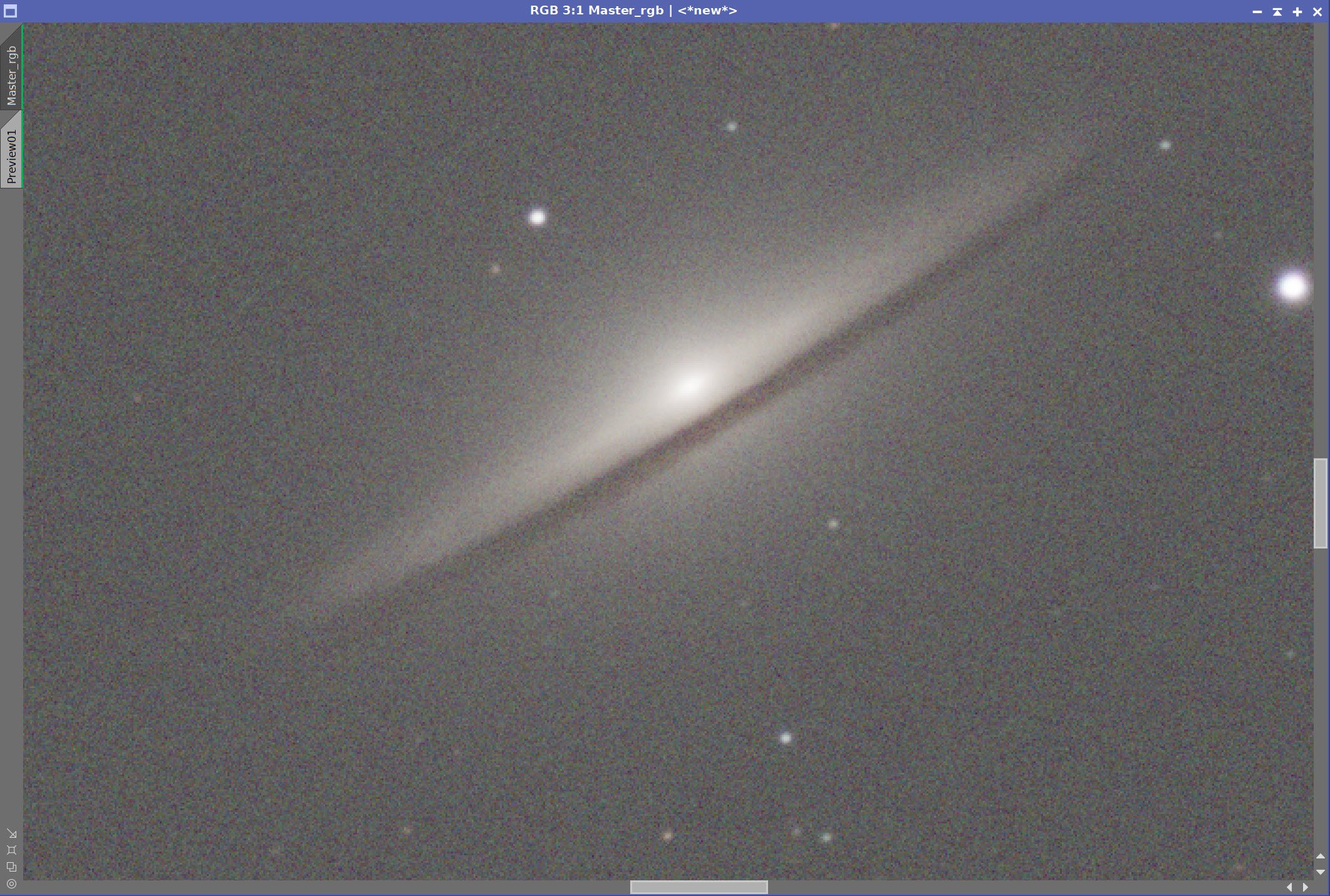
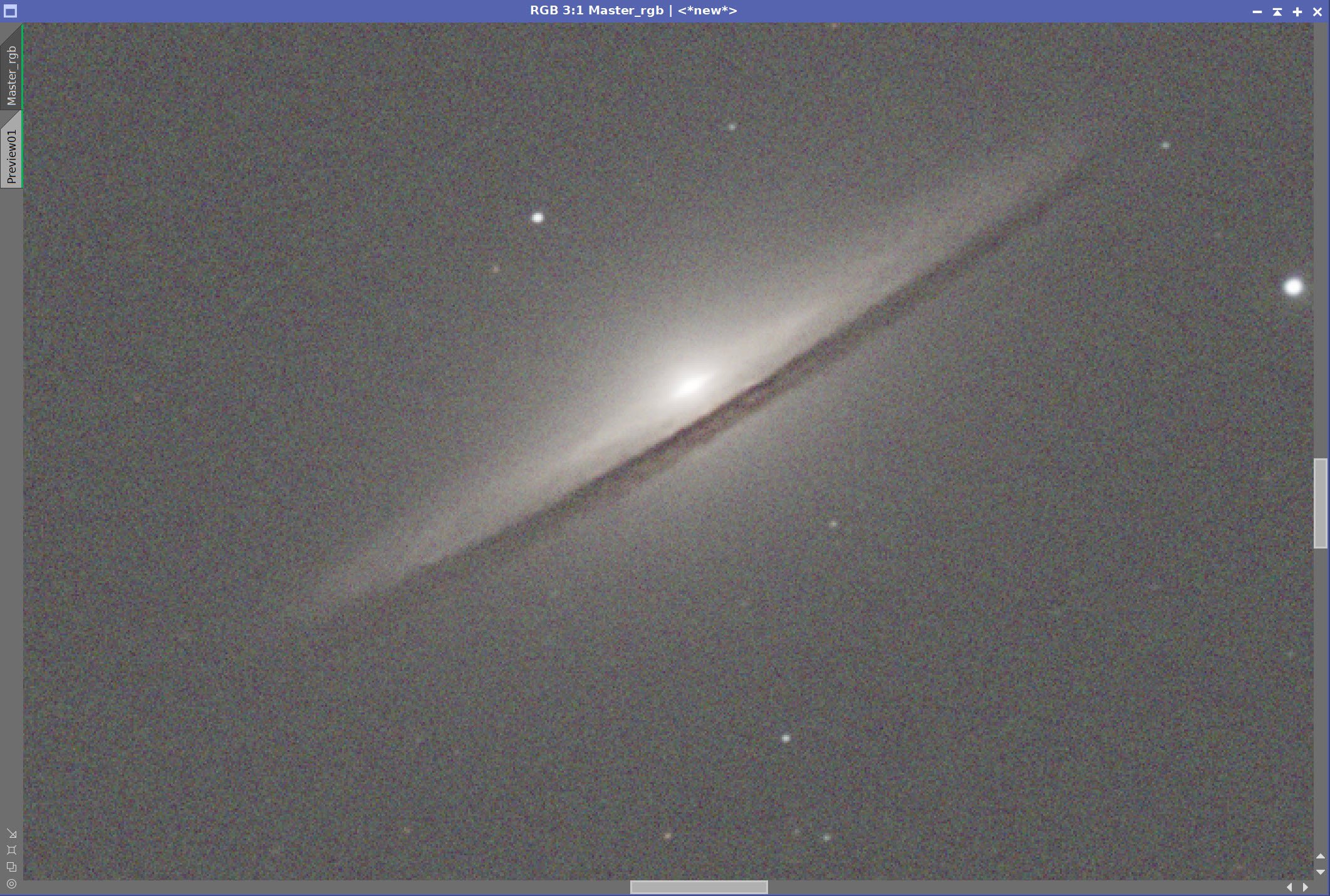

Master RGB Before and After BXT and then After NXT
7.0 Process Lum Image
Run PFSImage to get FWHM for X and Y: 4.13, 3.37
Experiment with BXT to get the best Values.
Run BXT
Correct first
Stellar Correction: 0.32, Halo: 0.0
Non Stellar: 5.0, 0.9
Run NXT at 0.55
The PSFImage results showing the FWHM for X and Y.
BXT Panel config for Lum Image
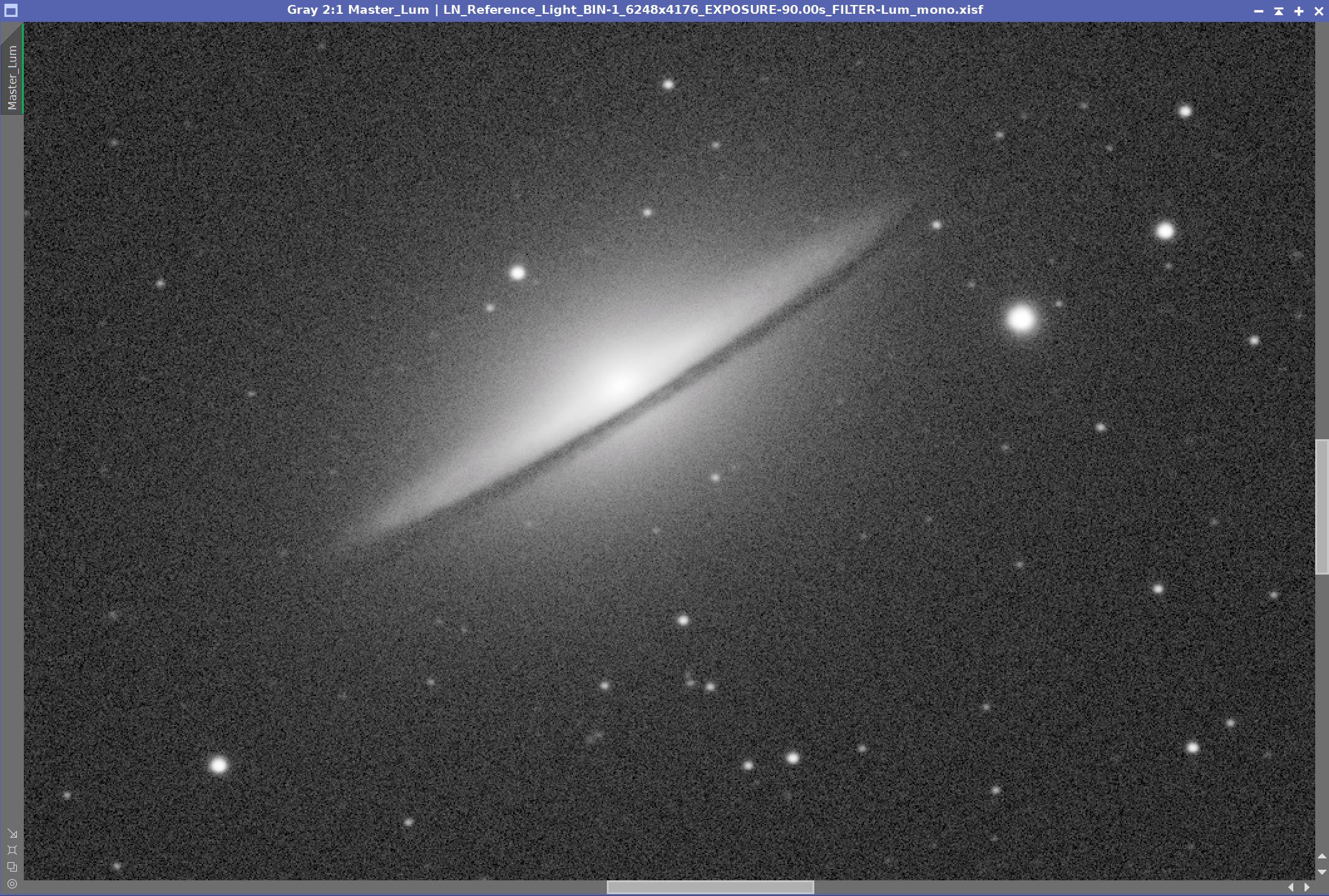
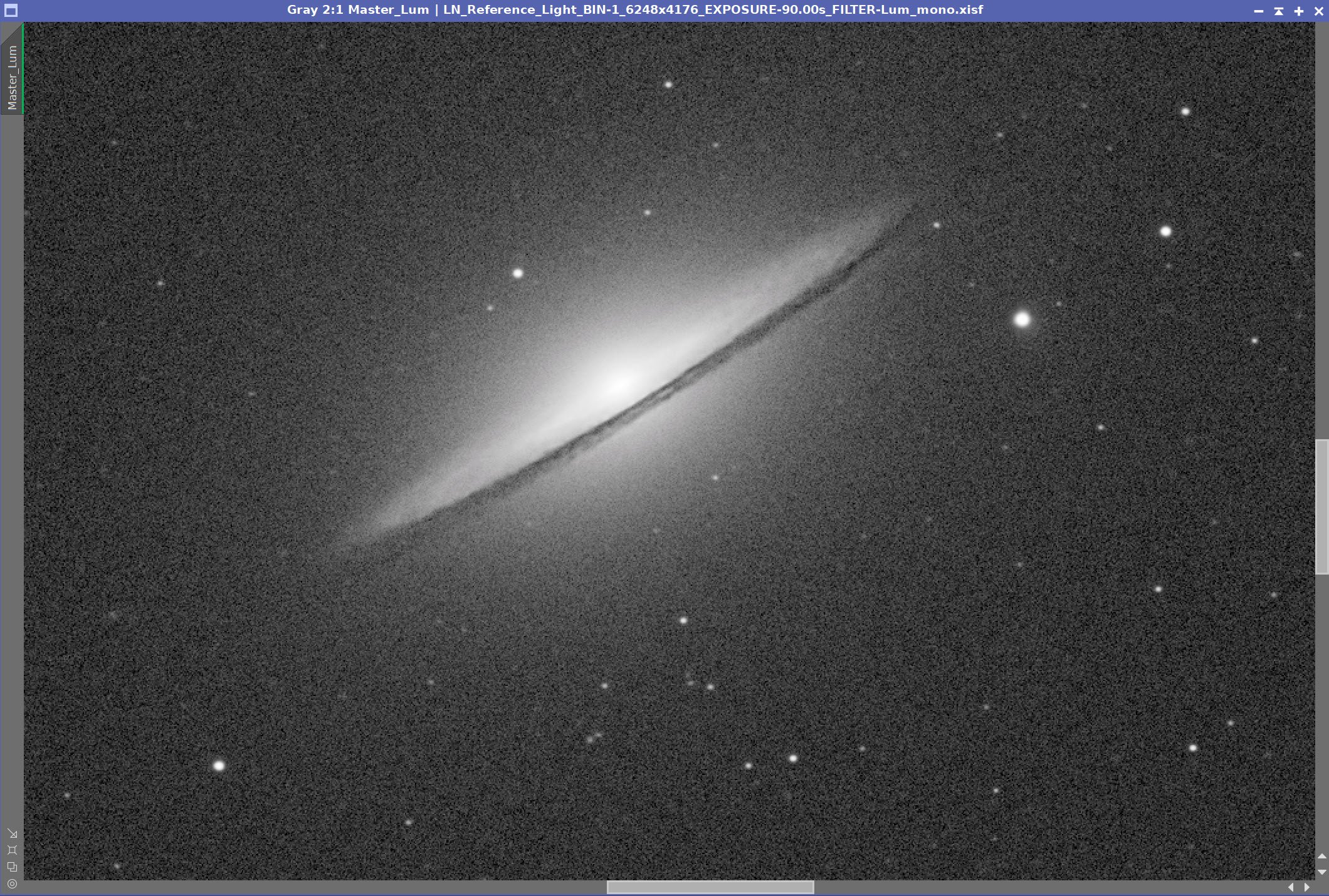
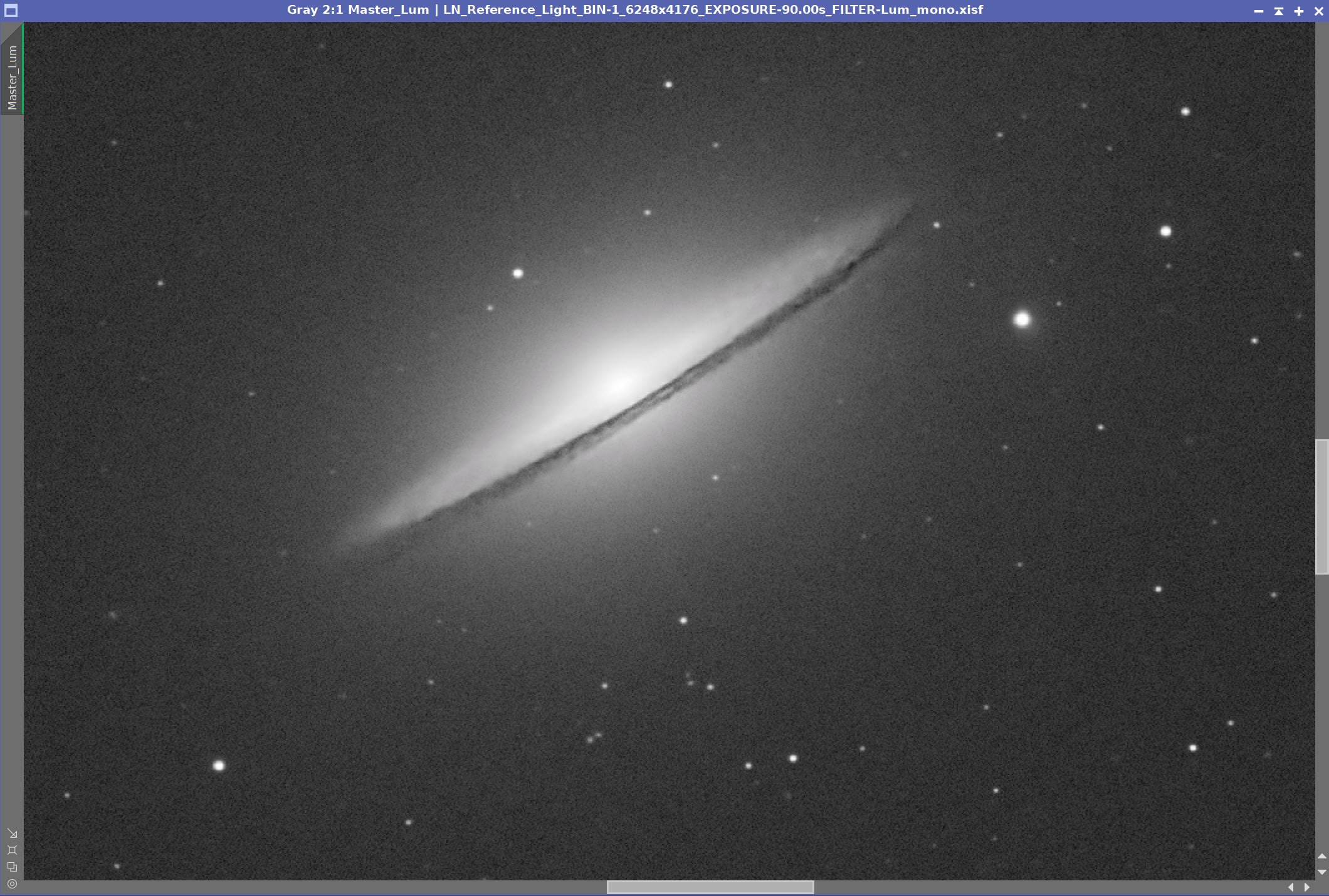
Lum: Before BXT, After BXT, After NXT=0.55
8.0 Take Images Nonlinear
For both RGB and Lum:
Since we will be using a starless workflow, use the STF->HT method to go nonlinear
Do a final adjustment with CT.
Final Linear Lum and RGB Images - ready to go Nonlinear.
Nonlinear Lum image - Initial (click to enlarge)
Nonlinear Lum image -After CT Tweak(click to enlarge)
Nonlinear RGB image - Initial (click to enlarge)
Nonlinear RGB image -After CT Tweak(click to enlarge)
9.0 Go Starless
Run StarXTerminator on the Nonlinear RGB image - creating a stars-only image and a Starless image using the Unscreen Method.
Run StarXTerminator on the Nonlinear Lum image - creating no stars-only image.
Initial RGB Starless Image (click to enlarge)
Nonlinear Lum Image (click to enlarge)
RGB Stars-Only Image (click to enlarge)
10. Process Lum Starless Image
Run HDRMT, using level 7, and “To Lightness”, and “Lightness Mask” options
Use CT to adjust the resulting tone scale
Use the Game Script to create a Galaxy Gradient Mask
Apply the Galaxy Mask
Apply LHE: Radius=22, Constast Limit=2.0, Amount= 0.35, 8-bit histogram
Remove the mask
Run MLT in sharpening mode - see panel screenshot below for parameters
Run NoiseXTerminator with a value of 0.6
Galaxy Mask
The MLT Sharpening Params used.
Nonlin Lum Processing Steps
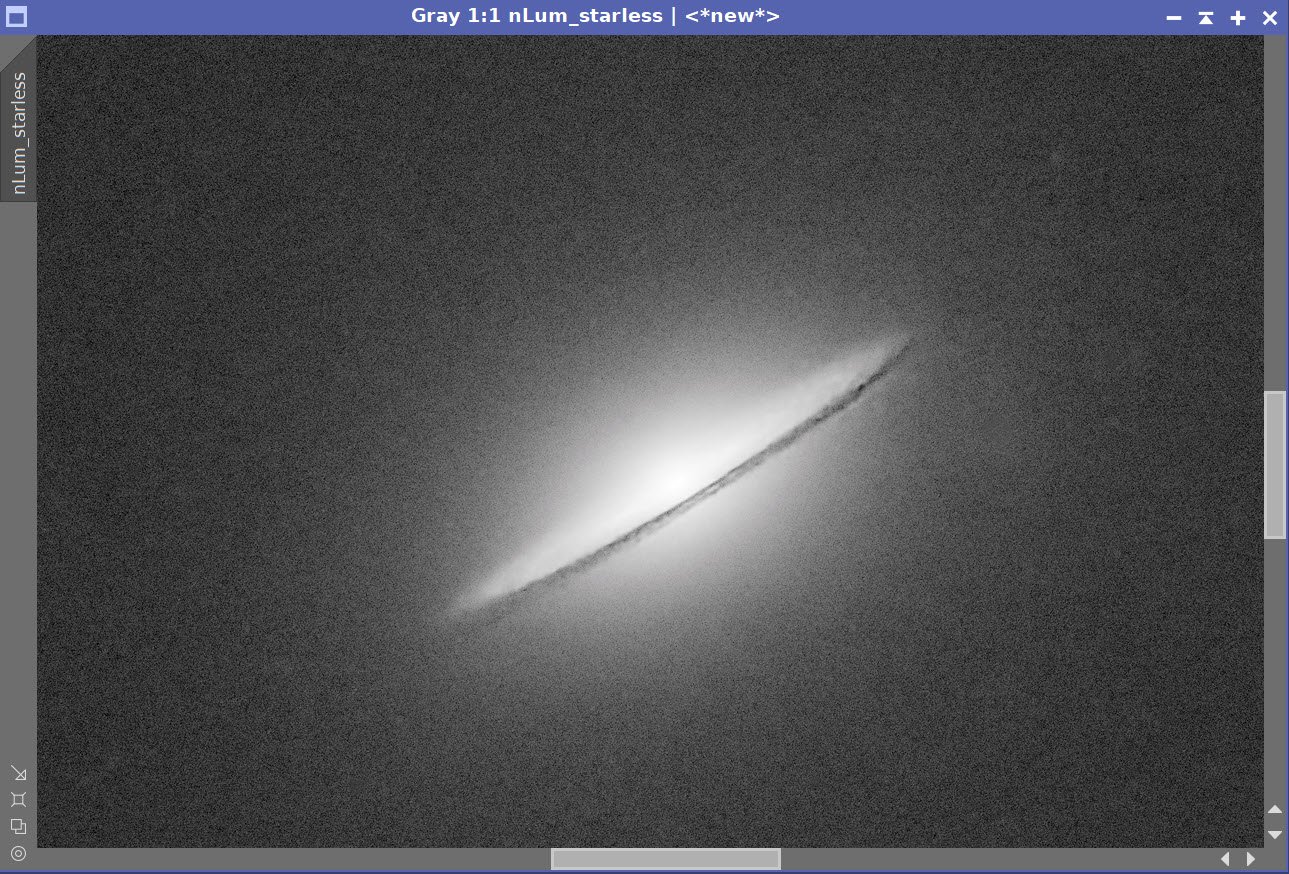

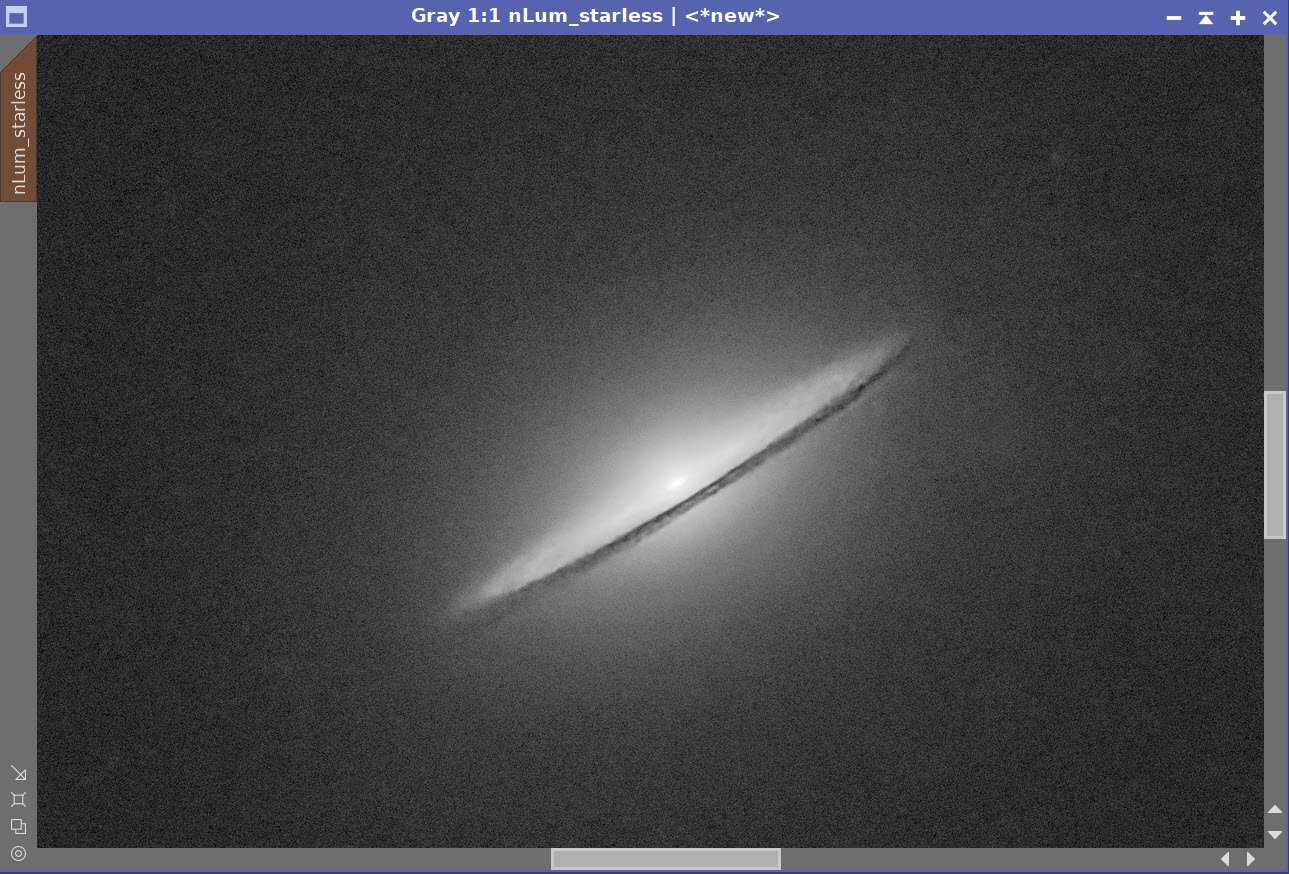
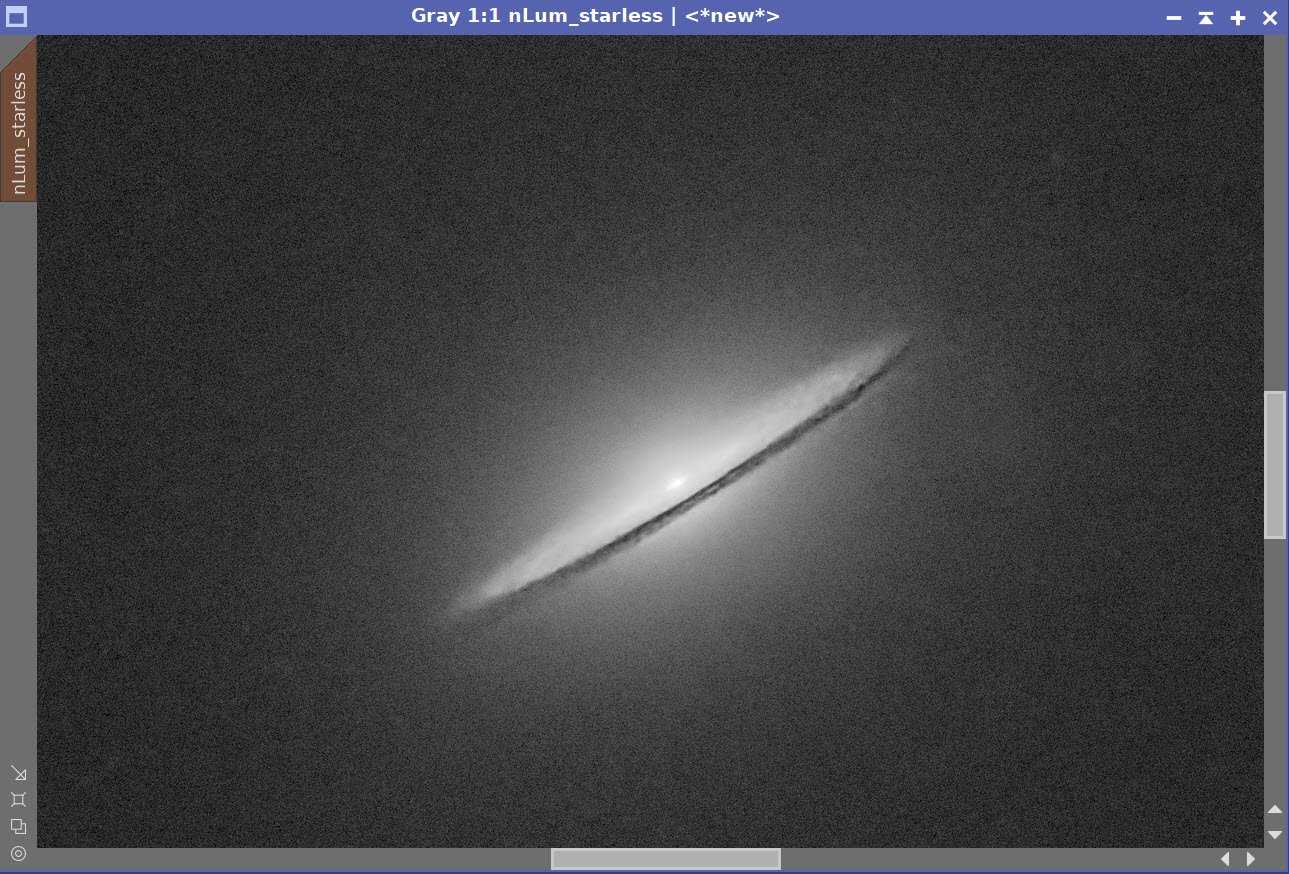
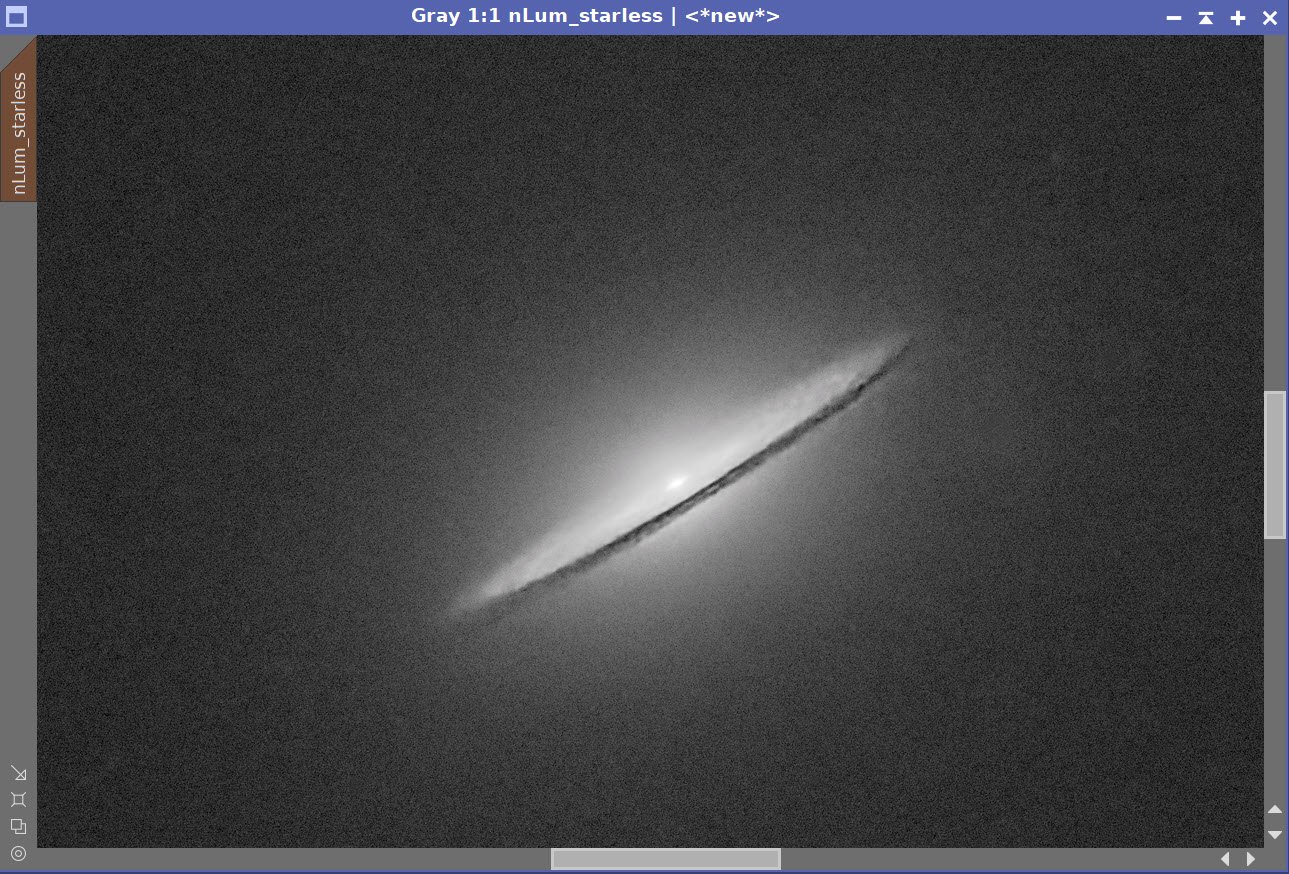
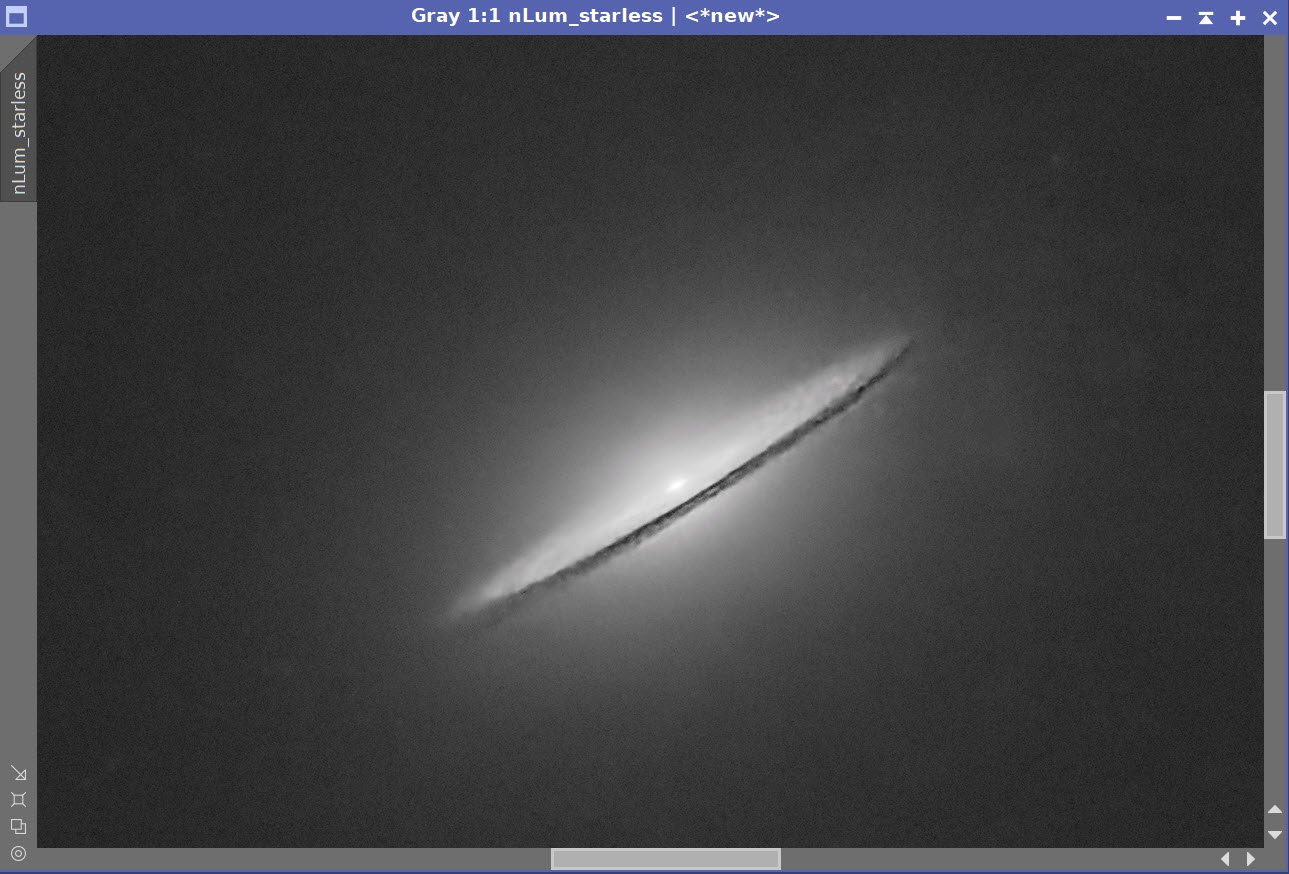
Process Steps Shown
Starting Nonlin Lum Image
After HDRMT levels=7
After CT Adjust
After LHE 22,2.0,0.35, 8-bit Histogram w/ Galaxy Mask
After MLT Sharpening w/ Galaxy Mask
After NXT 0.6 No mask
11.0 Process the RGB Starless Image
Adjust with CT
Run NXT with 0.76
Combine L starless image with LRGBBCombination Tool
Adjust with CT
Nonlin RGB Processing Sequence
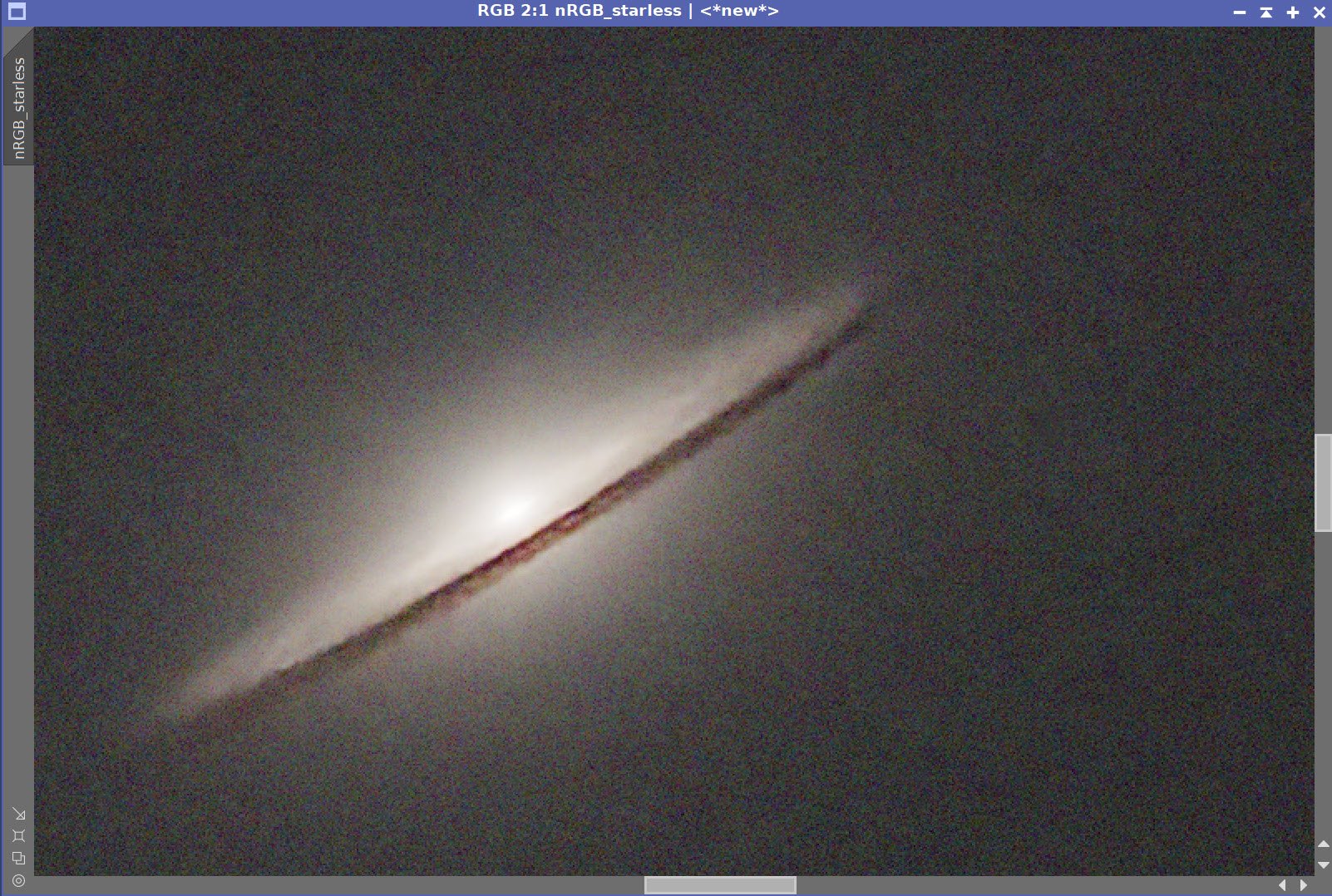
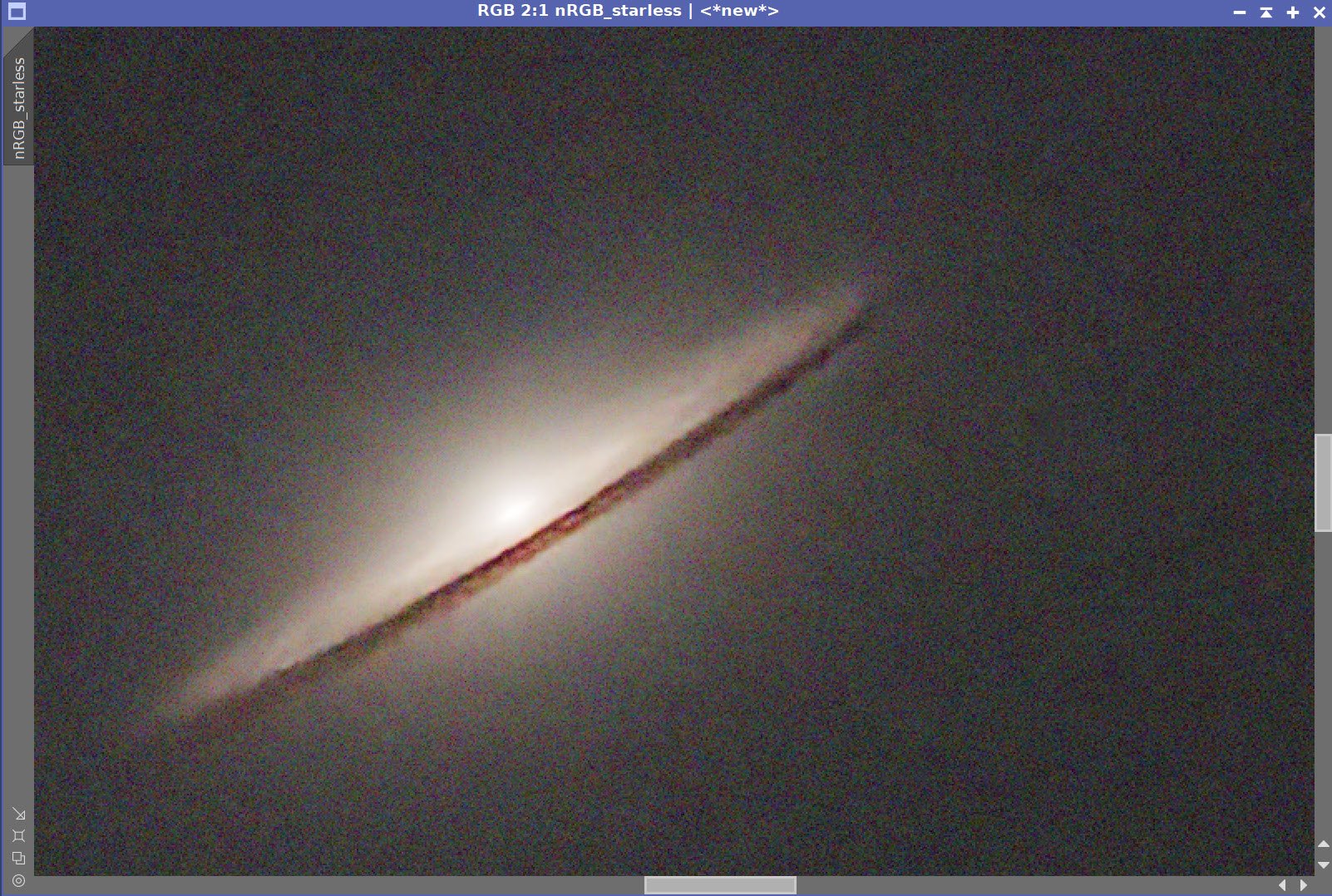
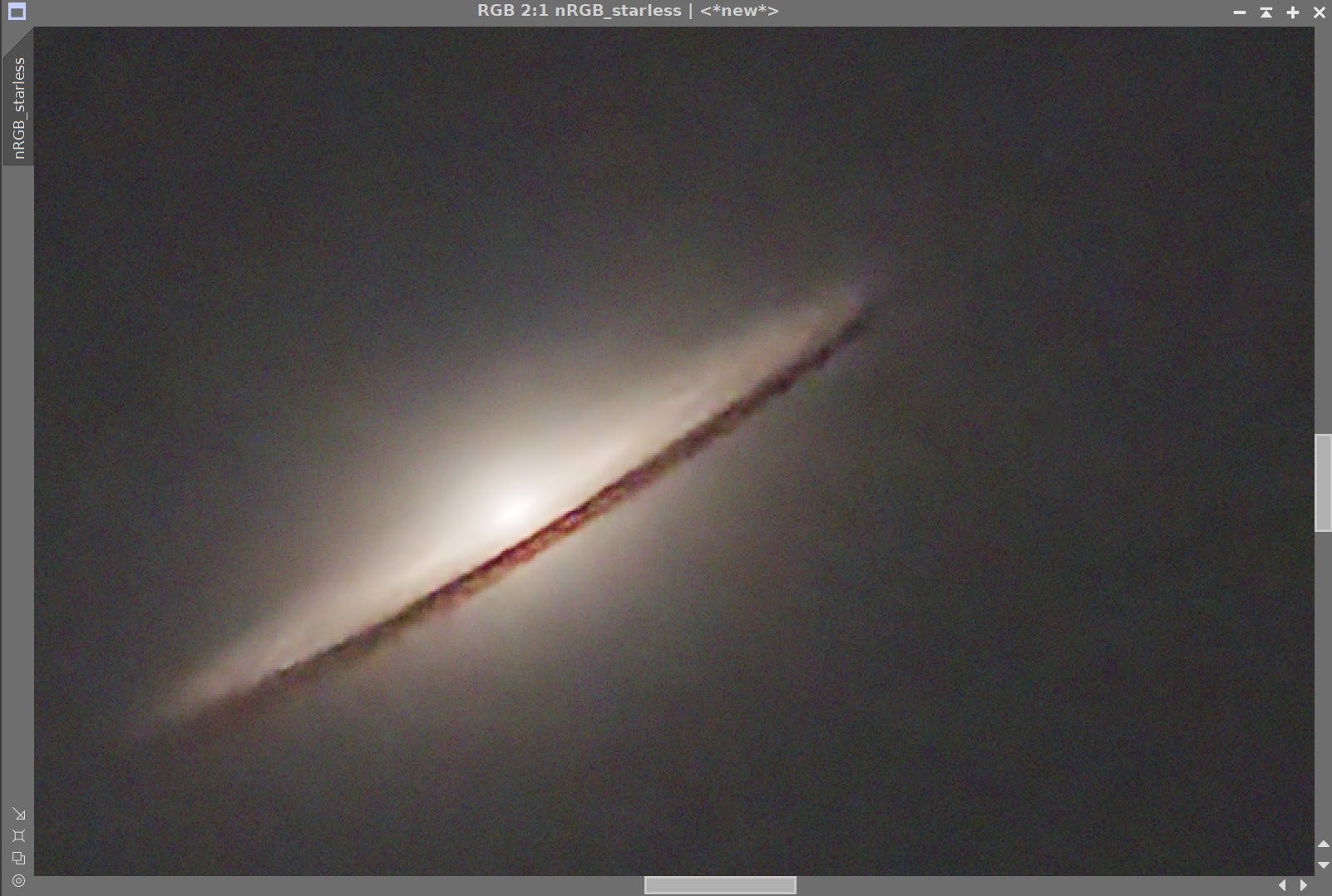
Process Steps Shown
Starting Nonlin RGB Image Zoomed
After CT Adjust
After NXT 0.6
Nonlin RGB Processing Sequence - After Lum Image Insertion
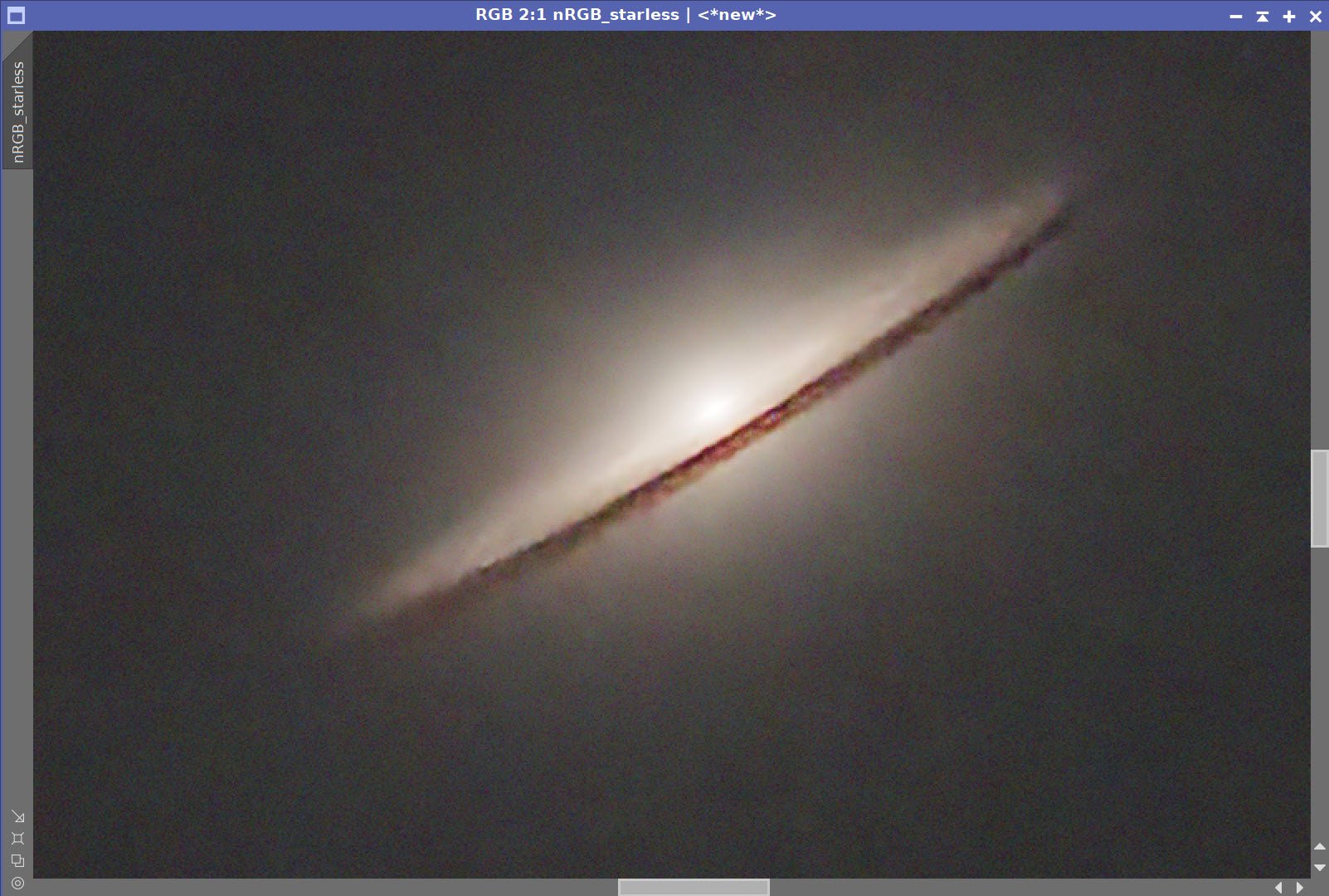
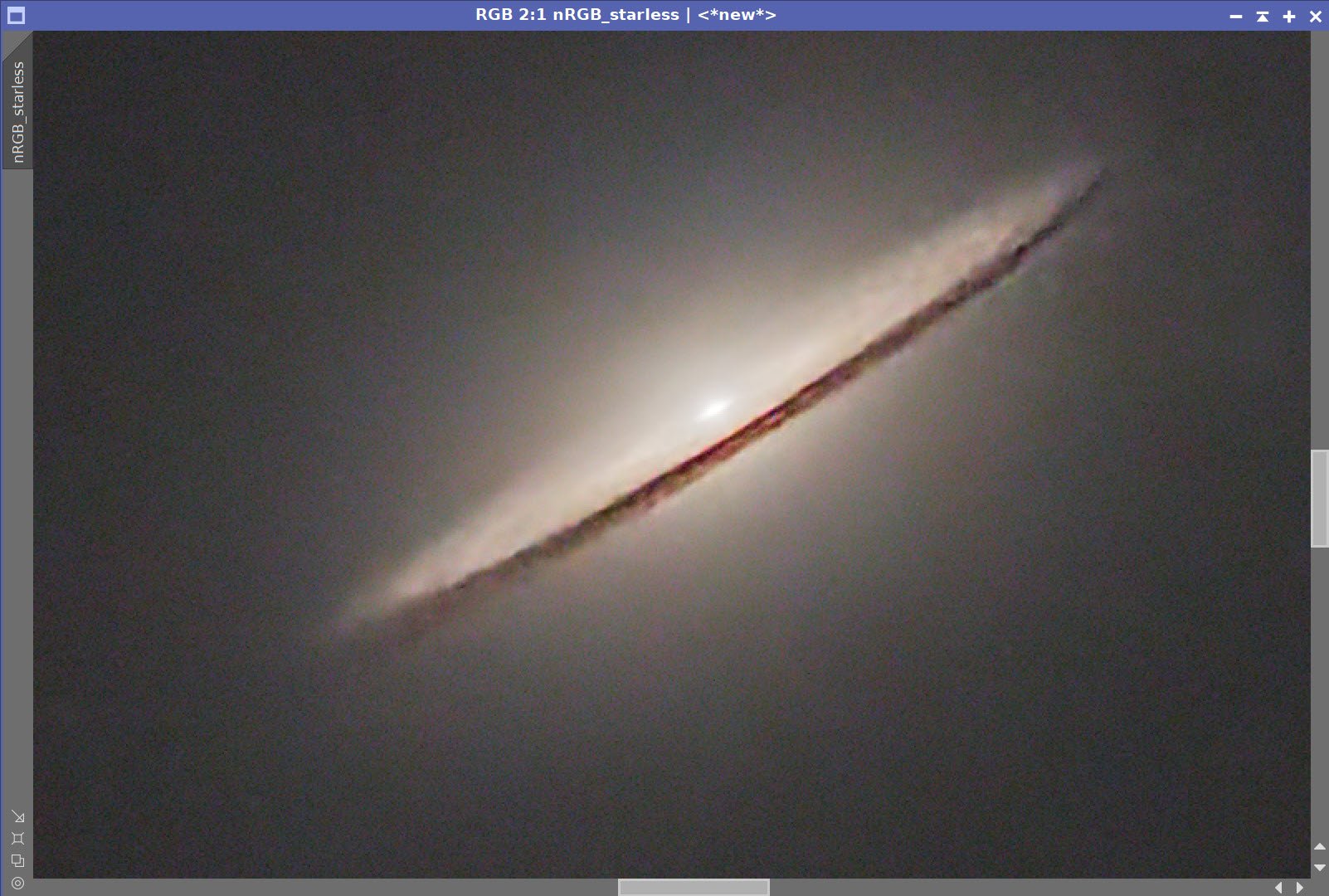
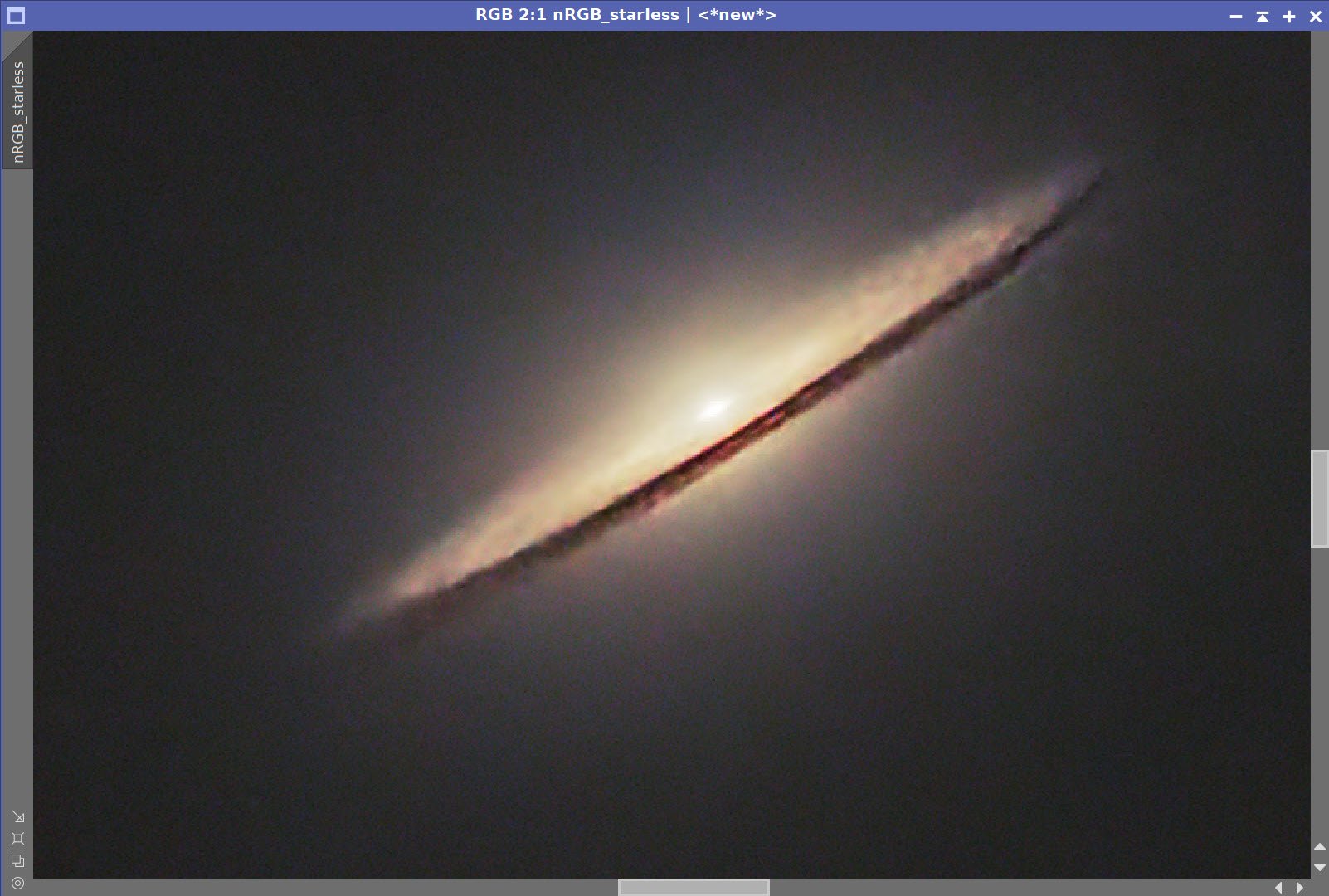
Process Steps Shown
RGB Before L-Insertion Zoomed
After L-Insertion
After CT Adjust
12.0 Process The Stars
Apply CT to reduce star intensity and increase color saturation.
Initlal RGB Stars Only image
RGB Stars Only Image After CT Tweak.
13.0 Add Stars Back in
Use PixelMath and the Screening equation to add the star images to the starless images.
Crop image to highlight the nebula and the galaxy better.
Apply Bill Blanshan’s Star Reduction Script - see screen shot.
PixelMath Screening Equation used to add star and starless images back together.
Bill Blanshan’s Star Reduction Script with value used.
Recombined Image
After Crop to emphasize the Galaxy.
After doing Bill Blanshan’s Star Reduction Script
14.0 Export to Photoshop
Save images as Tiff 16-bit unsigned and move to Photoshop
I tweaked things with the camera filter clarity, curves, and color mix - in a global adjustment
I added watermarks and title sections.
Export Clear, Watermarked, and Web-sized jpegs.
The final Image.




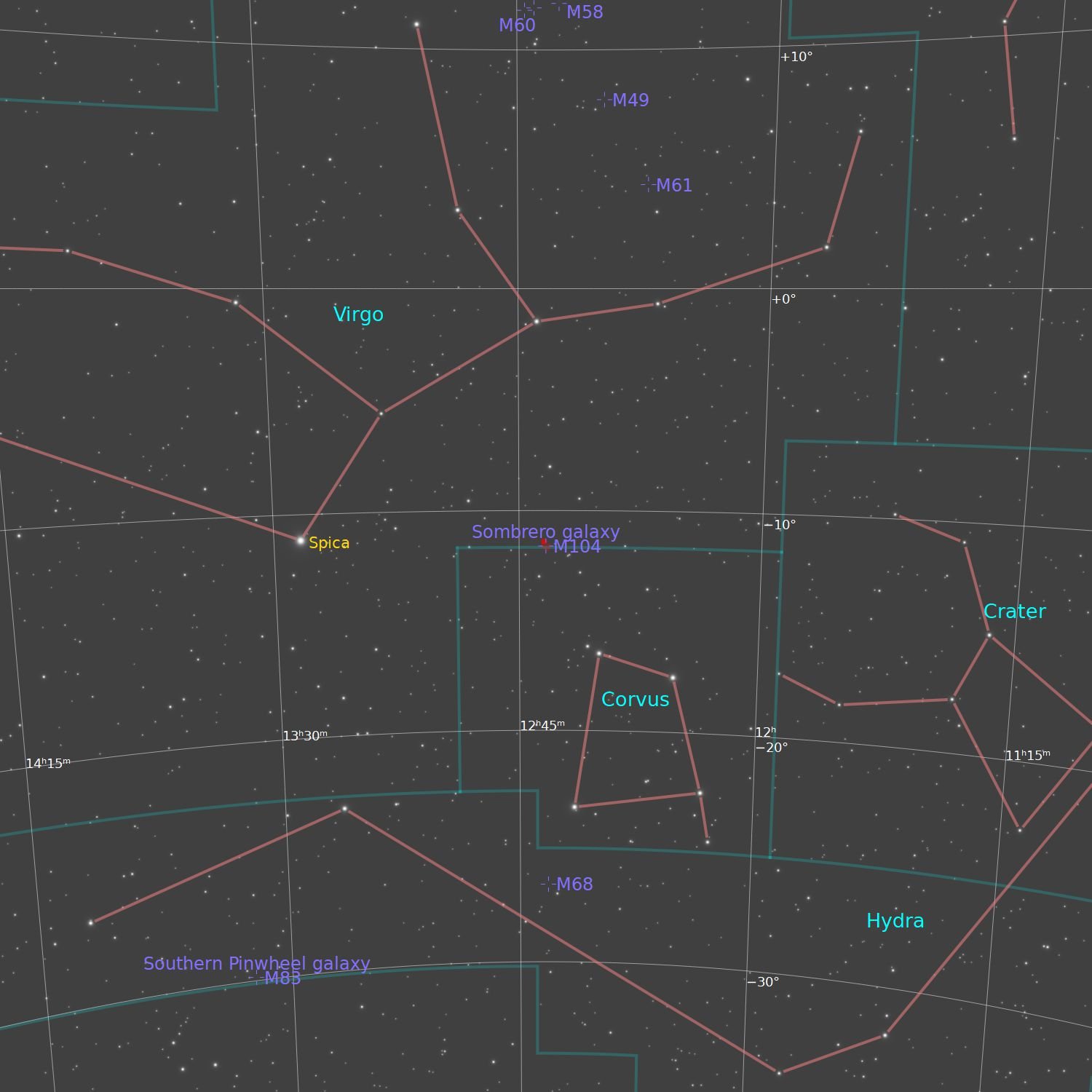

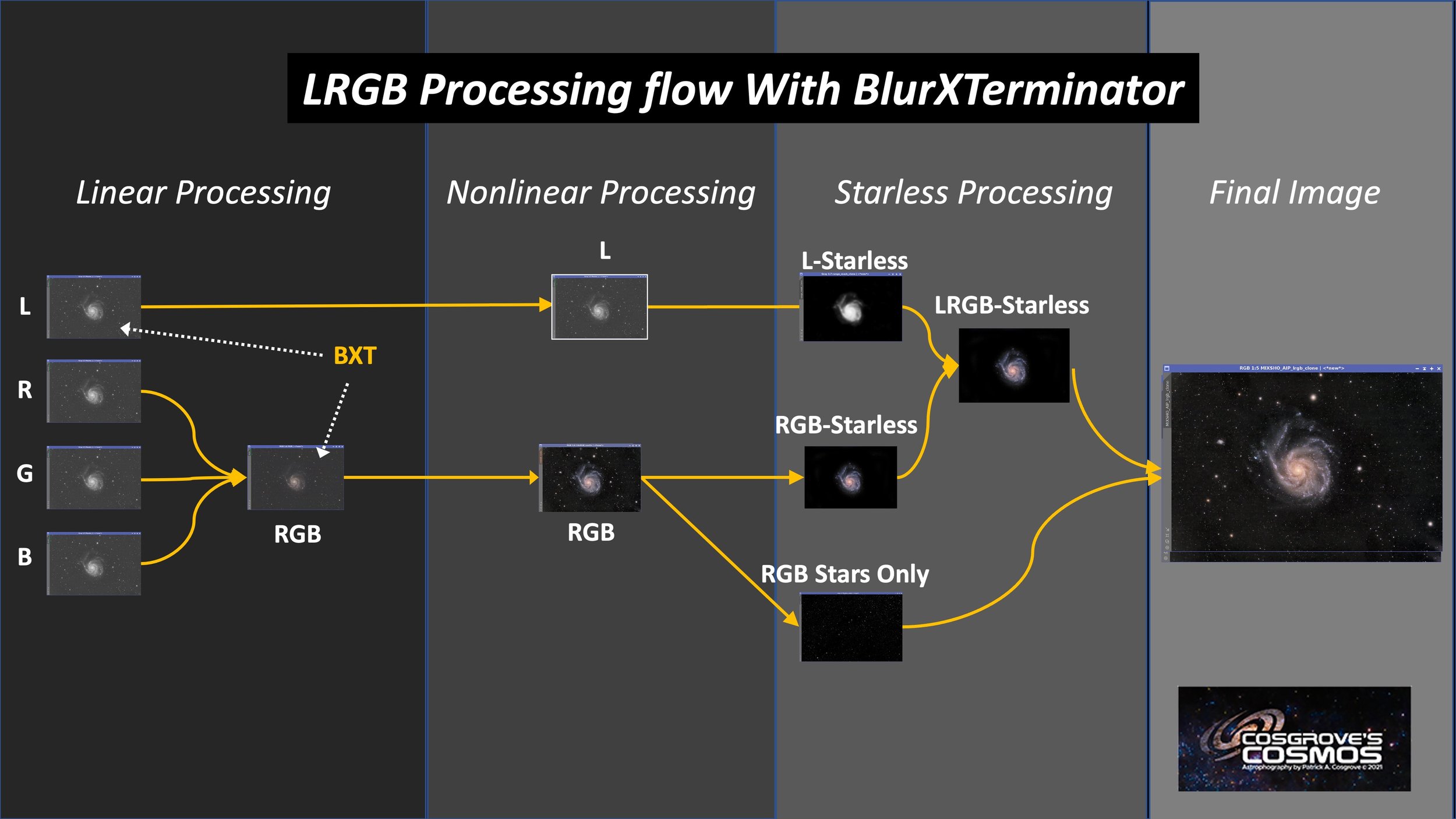





















Adding the next generation ZWO ASI2600MM-Pro camera and ZWO EFW 7x36 II EFW to the platform…